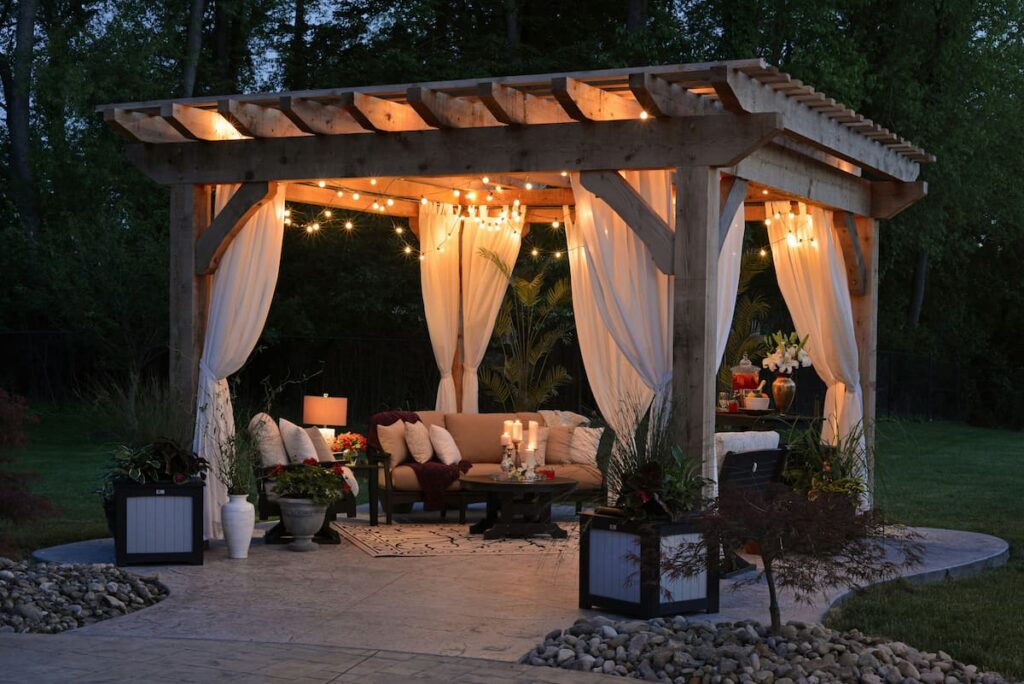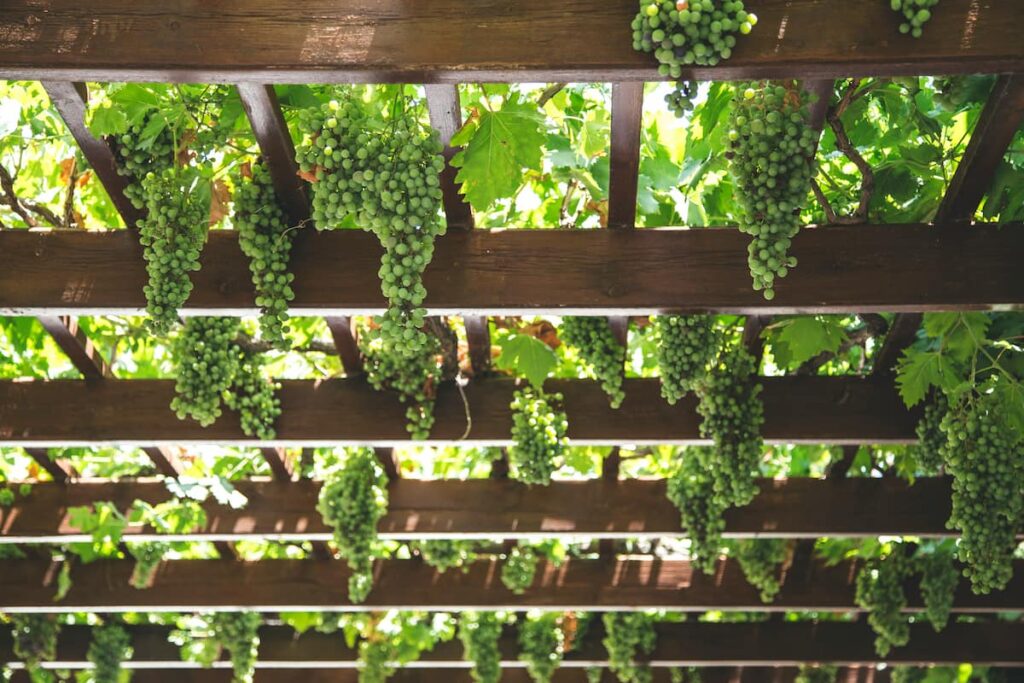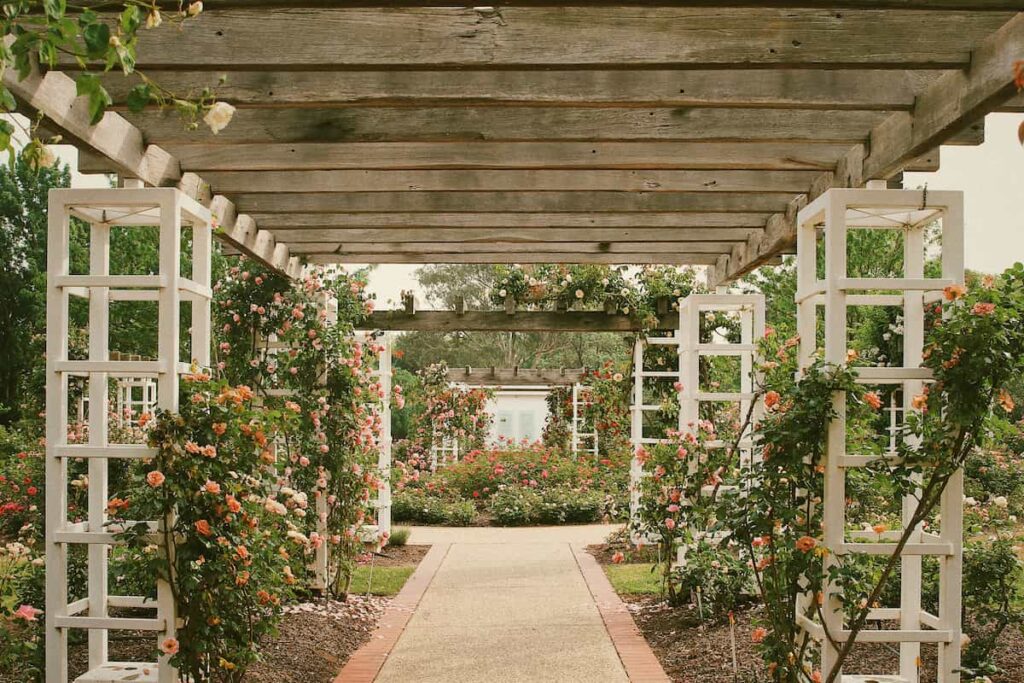
Do you want to understand what a pergola is? In this blog post we take a look into the uses of a pergola, its history, how much it costs and even which plants are best to grow on it. And, if you’ve ever been confused about the differences between pergolas, arbours and gazebos, you’ll be glad to know we also explain how they differ from each other. Let’s jump right in.
A pergola is an architectural structure that is usually made of wood and stands on pillars or columns. The top of the structure is made of beams and rafters. You can usually find pergolas built on top of walkways or over terraces as free-standing structures, but they can also be built to cover an entrance area to a building or next to a wall.
Pergolas are often confused with other garden structures such as gazebos and pavilions . Unlike gazebos and pavilions, which have a roof, pergolas have an open top, although they can have an additional cover these days. Arbors are usually square in shape, while pavilions are rectangular.
And arbor is similar to a pergola, but it is much smaller. They can often be recognized by their distinctive arch shape. Arbors are a lovely addition to any garden and are mainly used as an entrance.
Pergolas mainly have two uses:
Pergolas provide protection against the weather. Without blocking out the sun completely, you can enjoy taking cover under a beautiful pergola or on a hot summer day. It’s also perfect to escape from rain or a slight drizzle. A polycarbonate or fabric cover can be added on top of the pergola for better cover. Climbing plants may also cover pergolas completely, forming a roof in time. A pergola is not only a practical addition to your garden, it’s a striking focal point or feature that elevates the feel of your entire garden.

Grapes are a fantastic traditional choice as a plant to grow on your pergola. It’s not hard to imagine a lovely dinner under your pergola with close friends. For dessert, you can pick the grapes fresh from your own garden – how amazing is that? An added trellis or latice can increase the growing space further if you want to add more plants.
There are many different pergolas available, made from different materials and of different quality. The price usually reflects the quality, so consider carefully, whether the cheapest option is a good idea. The cheapest pergolas you can find online are aluminum pergolas that start from around €300.00, while wooden pergolas start at around €400.00.
We recommend that you compare the quality of the materials and read reviews before purchasing, paying attention to the quality of the components.

The word pergola comes from the Late Latin ‘pergula’. It was a term used to refer to an eave, ie the part of the roof that overhangs the wall to deflect rain. It is thought to come from the Latin word ‘pergere’, meaning to advance or go forward. ¹
The first person to use the word ‘pergola’ in writing was Sir John Evelyn in 1645. He described the structures he saw during his visit to Italy, using the term in an English-speaking context. 23
The oldest records of pergolas come from Egypt, dating back almost 3500 years! A high officials garden plans from 1400 BC revealed a pergola built over an entrance.
Pergolas in Spain have a rich history dating back to Roman times (1st century BC – 5th century AD). During the Muslim period (8th-15th centuries), pergolas were integrated into Andalusian gardens, offering coolness and shade in precisely designed spaces. In the Renaissance and Baroque periods (16th-18th centuries), they became more ornamental in the gardens of palaces and stately homes. In the 19th and 20th centuries, pergolas became more diverse and were made of new materials such as iron and steel, combining tradition and modern design. ⁴

There is a wide variety of flowers and climbing plants that are well adapted to the Spanish climate and that you can choose according to the style of your garden and your personal tastes.
Jasmine: Jasmine, especially star jasmine ( jasminum nitidum ) or evergreen jasmine ( jasminum officinale ), offers fragrance and beautiful white or yellow flowers.
Bougainvillea: In warm climate regions, bougainvillea is excellent for its colorful flowers and vigorous growth. It adds an exotic and vibrant touch to pergolas.
Wisteria: This plant is known for its impressive clusters of purple, blue or white flowers. It is ideal for pergolas because of its fast growth and ability to cover large areas.
Climbing rose: Climbing roses are popular for their beautiful flowers and fragrance. There are many varieties, offering different colors and flower shapes.
Ivy: Ivy is a hardy, fast-growing option that provides dense, green cover all year round. It is especially useful in colder climates or for creating a privacy screen.
Climbing vine: Climbing vine not only provides shade, but also produces edible grapes. It is ideal for pergolas if you are looking for a plant that combines functionality and aesthetics.
Pergolas are made to protect people from the elements. They are great in providing shade or even protection from the rain as long as there’s enough vegetation or a polycarbonate cover, for example.
Pergolas are made of different materials, such as wood, metal and vinyl.
A roofed pergola is often called a pavilion or gazebo. Like pergolas, pavilions and gazebos can make a big difference to the appearance and use of your garden.
For a cost-effective solution, you can opt for materials such as canvas or polycarbonate plastic. These materials are affordable compared to more expensive options such as shingles or glass roofs and offer good protection against sun and rain.
A bioclimatic pergola is a type of pergola that is designed to adapt to climatic conditions and improve comfort in outdoor spaces. These pergolas are equipped with adjustable slats on top, which allow you to regulate the amount of sunlight and ventilation. They also offer protection against rain.
The height of a pergola is usually between 2.5 and 3.5 meters. However, you can build or purchase a pergola of different dimensions depending on your needs. Be sure to check local regulations and requirements about the height of garden buildings before proceeding.
The time required to install or build a pergola can vary significantly depending on the type of pergola you choose, who installs it and any additional work required. In general, the process can take only a few hours. If you’re doing it as a DIY project, you should budget more time – a day or two.
People have been using pergolas in their gardens for thousands of years, and for good reason. These structures are a great way to add beauty and also improve the functionality of outdoor spaces. If you are looking to create a haven in your garden, consider the high-quality gazebos and pavilions from Casetas de Jardín 24 . Each structure is crafted with meticulous attention to detail and the finest Nordic timber, which lasts for decades. We also offer professional delivery throughout Spain to make the process as convenient as possible for you, so why not take a look at our gazebos and pergolas today?
Sources used: